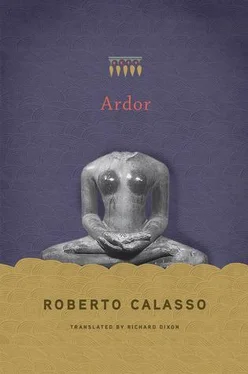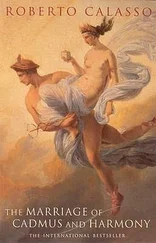* * *
The Vedic seers saw the hymns of the Ṛgveda in much the same way that others among them found the rites that were later to be celebrated and studied. Knowledge was an encounter with something preexisting, sight of which the gods now and then allowed. They were not interested in educating and guiding the human race, which they looked upon with mixed feelings, sometimes benevolent sometimes hostile, so that “from time to time, following the whim of the moment, the celestial power communicates to mankind first one, then another fragment of inestimable knowledge” (Oldenberg again).
How, though, was this knowledge deposited and arranged? The metrics are too perfect, the vocabulary too varied, the overall composition too complex, so it must be presumed that the Ṛgveda —the concrete product of that knowledge — was developed over a long period that began before even the descent into India, in other regions toward the northwest, and in other climates. Traces of these events, enigmatic as always, can be spotted in certain hymns. The most dazzling ancient poetry is already imitating an archaic style, as if the earliest Greek statuary were that of the Master of Olympia. When it first came to us, passed down through thousands of memories, unaltered, the word of the ṛṣis seemed already to be a “tributary of a long, learned tradition.” And the Ṛgveda was already a saṃhitā , a “collection,” an anthology that “mixes together an older, less differentiated, mass that heads of clans or schools would have drawn from at different moments.”
* * *
When something (or someone) is created, produced, emanated, composed — especially at the beginning of the world — the Vedic texts repeat countless times that this happened through tapas , “ardor.” But what is tapas ? Many Indologists have avoided the question, having been led astray by the Christianizing translations (“asceticism,” “penance,” “mortification”) that began with the first nineteenth-century editions (and can still be found today). After all, it is well-known that ascetics, penitents, and disciples practicing self-mortification are to be found in India more than anywhere else. They, it is said, are the latest practitioners of tapas. And the question would seem to be resolved with a general reference to spirituality.
Now tapas is certainly a form of asceticism in the original sense of “exercise,” but it is a very particular exercise that implies the developing of heat. Tapas is akin to the Latin word tepor —and indicates fervor, ardor. Those who practice tapas could be described as “ardent.” They generate a heat that can become a devastating blaze. This is what happened with various ṛṣis who every so often shook the world.
The ṛṣis are not gods, they are not demons, they are not men. But they often appear earlier than the gods, indeed earlier than the being from which the gods had emanated; they often display demonic powers; they often move about like people among people. The Vedic texts feign indifference toward these incompatibilities, as if they didn’t recognize them, perhaps because the hymns of the Ṛgveda appear to be composed by the ṛṣis themselves. Elsewhere, in other places and periods, we search in vain for figures that combine their characteristics, all converging into one: incandescence of mind. With this the ṛṣis were capable of attacking all other beings, whether gods, men, or animals.
The ṛṣis reached an unattainable level of knowledge not just because they thought certain thoughts but because they burned. Ardor comes before thought. Thoughts are given off like steam from a boiling liquid. While the ṛṣis were sitting, motionless, and contemplating what was happening in the world, whirling inside them was a scorching spiral that would one day break off to become the hymns of the Ṛgveda or the “great sayings,” mahāvākya , of the Upaniṣads.
There is nothing more misleading than to imagine the ṛṣis , and above all the Seven Seers, as calm and affable beings, detached from the world’s vicissitudes. On the contrary, if the world continues on its course, it is primarily due to the immense reserves of tapas that the Seven Seers channel, moment by moment, into the veins of the universe. But this tapas can occasionally be directed against the world itself — and wreak havoc. Nor can it be said that the incandescent mass of ardor lets itself be steered by the ṛṣis. When Vasiṣṭha, one of the Seven Seers, wishes to kill himself in despair over the death of his children, his tapas prevents him from doing so. He threw himself off a very high cliff, only to land on a vast lotus, as if on a soft bed. His tapas was too powerful to allow its bearer to kill himself.
* * *
The story of the relationship between the Seven Seers and their consorts, the Pleiades, dates back to the earliest times, and is never properly explained. The Saptarṣis, in their celestial residences, signaled the north with the Pole Star. If they had once also been called “bears,” ṛkṣa , there was presumably something in their appearance that resembled those animals, in the same way that we see the Seven Apkallus of Sumer, the “Holy Carps,” covered in fish scales. The Saptarṣis were three pairs of twins, plus a “seventh single-born.” They were loved and respected by their consorts but separated from them by a vast expanse of sky, since the Pleiades lie to the east. So Agni, their first lover, crept in. He was the first to seduce the lonely women neglected by their husbands. With his flames he began licking the toes of the wives of the ṛṣis , while they were gathered around the fire. In the end he became the lover of each of them. Only the stern Arundhatī refused him. Thus one day, when the Pleiades went down to the waters of a reed bed to meet the runaway Agni, it was an old lover in difficulty they found.
When it came to deciding on setting up the fires, the ritualists pondered: should the protection of the Pleiades be refused, since they were adulterers, or sought for the same reason, since they betrayed the ṛṣis with Agni? The alternative was this: either to place the fires under the Pleiades, seeking in some way to attract their complicit gaze, or keep away from them, as they were an example of adultery — or at least, of the couple’s distance (and at this point the worried ritualist noted “it is a misfortune not to have intercourse [with one’s wife]”). The dilemma raised once again a delicate, recurring question. The ṛṣis are sages with immense power, formidable anger, often contemptuous and stern even toward the gods. But they are unable to ensure the fidelity of their wives. The Pleiades, who were ravishing and also severe, couldn’t resist the enticements of a god. This was what happened with Agni, their long-term lover. But the most scandalous event was Śiva’s visit to the Cedar Forest, when they followed him dancing, in rapture. The story itself took place against a background of cruel revenge. The ṛṣis were above all the husbands chosen by Dakṣa for his daughters. And Śiva was he who had taken Satī, Dakṣa’s favorite daughter, against his will. This was the beginning of the conflict that ended with the burning of Satī’s body. And Śiva, through the ṛṣis , now mocked those in the world who would continue to represent Dakṣa’s authority, his priestly power.
Tracing these stories back to their origins within the divine, they were a new expression, in erotic terms, of the conflict between Brahmā and Śiva, as a result of which Śiva had cut off Brahmā’s fifth head and had then spent a long time wandering about dressed as a beggar, with the god’s skull fastened to his hand as a bowl. But what had caused the conflict between Brahmā and Śiva? That is highly unclear, little can be gleaned about it. While Brahmā is the source of order and priestly authority, Śiva is the perpetual certainty that this order will eventually break down, that it will not withstand the impact of a force that exists beyond ritual. Order thus falls apart over the course of history. And this is why the Saptarṣis’s wives were powerless to resist Agni’s persistent, passionate courtship.
Читать дальше












